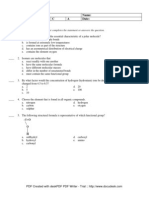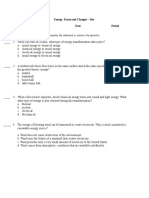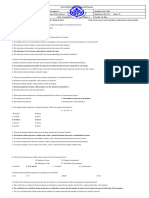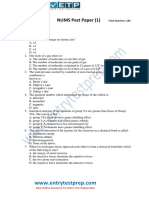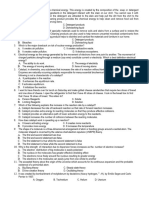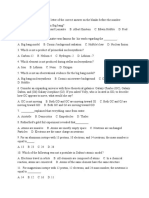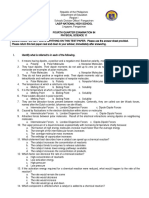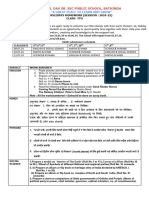100%(1)100% found this document useful (1 vote)
156 viewsSummative Test in Science VI 2014
Summative Test in Science VI 2014
Uploaded by
Mark Anthony FranciscoThe document contains a 15 question summative test on science covering various topics relating to energy. The questions test understanding of different forms of energy transfer including conduction, convection, radiation and heat. They also cover energy transformations, efficiency, kinetic and potential energy, and different sources of energy like nuclear, chemical and thermal. There are multiple choice and fill in the blank questions testing comprehension of concepts like acceleration, photosynthesis, and states of matter changes from gases to liquids.
Copyright:
© All Rights Reserved
Available Formats
Download as DOCX, PDF, TXT or read online from Scribd
Summative Test in Science VI 2014
Summative Test in Science VI 2014
Uploaded by
Mark Anthony Francisco100%(1)100% found this document useful (1 vote)
156 views3 pagesThe document contains a 15 question summative test on science covering various topics relating to energy. The questions test understanding of different forms of energy transfer including conduction, convection, radiation and heat. They also cover energy transformations, efficiency, kinetic and potential energy, and different sources of energy like nuclear, chemical and thermal. There are multiple choice and fill in the blank questions testing comprehension of concepts like acceleration, photosynthesis, and states of matter changes from gases to liquids.
Original Description:
Science VI
Copyright
© © All Rights Reserved
Available Formats
DOCX, PDF, TXT or read online from Scribd
Share this document
Did you find this document useful?
Is this content inappropriate?
The document contains a 15 question summative test on science covering various topics relating to energy. The questions test understanding of different forms of energy transfer including conduction, convection, radiation and heat. They also cover energy transformations, efficiency, kinetic and potential energy, and different sources of energy like nuclear, chemical and thermal. There are multiple choice and fill in the blank questions testing comprehension of concepts like acceleration, photosynthesis, and states of matter changes from gases to liquids.
Copyright:
© All Rights Reserved
Available Formats
Download as DOCX, PDF, TXT or read online from Scribd
Download as docx, pdf, or txt
100%(1)100% found this document useful (1 vote)
156 views3 pagesSummative Test in Science VI 2014
Summative Test in Science VI 2014
Uploaded by
Mark Anthony FranciscoThe document contains a 15 question summative test on science covering various topics relating to energy. The questions test understanding of different forms of energy transfer including conduction, convection, radiation and heat. They also cover energy transformations, efficiency, kinetic and potential energy, and different sources of energy like nuclear, chemical and thermal. There are multiple choice and fill in the blank questions testing comprehension of concepts like acceleration, photosynthesis, and states of matter changes from gases to liquids.
Copyright:
© All Rights Reserved
Available Formats
Download as DOCX, PDF, TXT or read online from Scribd
Download as docx, pdf, or txt
You are on page 1of 3
Summative Test in Science VI
DIRECTION: Read each question carefully. Choose the correct answer.
1. One of the disadvantages of using nuclear power as a source of electricity is
a. It uses only a small amount of raw material
c. It is a fairly clean process
b. It releases a large amount of heat to the environment
d. All of the above
2. Heat transfer is possible through
a. Conduction
b. Convection
c. Radiation
d.
All
of
these
3. Heat results in
a. Rise in temperature of the receiver
c. No change in temperature of the receiver
b. Lowering in temperature of the receiver
d. None of the above
4. Conversion efficiency is said to be low because
a. There is always some amount of wasted hear in conversions.
c. The temperature is
always maintained.
b. All of the energy is converted to useful work.
d. All of the above.
5. In energy transformation which is not true?
a. Energy is converted into a more usable form. c. All of the original energy is transformed
into usable form.
b. Heat energy is formed and released into the environment.
d. None of the
above
6. What do you need to enable you to accomplish many things?
a. Energy
b. Heat
c. Light
d. Sound
7. What energy is produced by the rapid movement of molecules?
a. Nuclear
b. Chemical
c. Heat
d.
Sound
8. What energy is used for communication, warning, entertainment but can also cause bodily
harm?
a. Mechanical
b. Chemical
c. Heat
d.
Sound
9. It refers to the rate of change in velocity.
a. Motion
b. Acceleration
c. Speed
d. None of the above
10. The energy stored in the leaves of plants in photosynthesis is
a. Mechanical Energy
b. Heat Energy
c. Chemical Energy d. All of the
above
11. Water is flowing from a faucet. What kind of energy does it have?
a. Kinetic
b. Potential
c. Chemical
d.
Heat
12. What kind of energy is gained by a liquid matter when heat is applied into it?
a. Chemical
b. Heat
c. Kinetic
d.
Potential
13. What happens when heat is taken away from a gas?
a. Gas particles lose their kinetic energy.
c. Gas turns or changes and forms into a
liquid.
b. Gas particles move closer to each other.
d. All are possible answers.
14.What kind of energy transformation is shown by water flowing at the edge of a dam?
a. Potential Kinetic Potential
c. Potential Potential Kinetic
b. Kinetic Potential Kinetic
d. Kinetic Kinetic Potential
15. How is nuclear energy produced?
a. By combining atoms with another atoms.
b. By breaking atoms into pieces.
c. By joining or fusing atoms together.
d. By all of these.
DIRECTION: Write the form of energy described by the following on the space provided for.
______________________________1. It is stored inside chemicals or in the molecules of matter.
______________________________2. It arrives as sunlight in the form of heat and light.
______________________________3. It is released when atoms of certain elements split.
______________________________4. It is generated by the rise and fall of the ocean or sea water
level.
______________________________5. It causes atoms and molecules of a substance to move about.
______________________________6. The waves rush to the shore.
______________________________7. The cars are in the parking area.
______________________________8. The horses gallop in the race.
______________________________9. The plant makes its own food.
______________________________10. The burning charcoal cooks the meal.
______________________________11. Sunlight dries the cloth.
______________________________12. The street lamp brightens the road.
______________________________13. The hammer is on the table.
______________________________14. The birds fly toward the swamp.
______________________________15. An atom has electrons and protons.
You might also like
- Test Bank For Introductory Chemistry, 2e Kevin Revell Test BankDocument8 pagesTest Bank For Introductory Chemistry, 2e Kevin Revell Test BankNail Basko0% (1)
- Midterm 1 BIS2A Section KeyDocument6 pagesMidterm 1 BIS2A Section KeyKevinZamudioNo ratings yet
- Unit Test 1 Grade 12 BioDocument8 pagesUnit Test 1 Grade 12 BioSarah KwanNo ratings yet
- General Science Natural Science ExamDocument7 pagesGeneral Science Natural Science ExamsheNo ratings yet
- Energy Forms and Changes TESTDocument9 pagesEnergy Forms and Changes TESTMark Jomar Mayor ArmentaNo ratings yet
- Energy Forms and Changes TESTDocument9 pagesEnergy Forms and Changes TESTAndrei100% (2)
- Yema CakeDocument6 pagesYema CakeMark Anthony FranciscoNo ratings yet
- Mould Contamination in Production of Semi-Hard CheeseDocument9 pagesMould Contamination in Production of Semi-Hard Cheesefdobonat613No ratings yet
- Does Absolute Truth ExistDocument6 pagesDoes Absolute Truth Existcfagadar31920% (1)
- Year 8 Science Half Yearly PracticeDocument5 pagesYear 8 Science Half Yearly Practiceyusri.alamNo ratings yet
- Physical Science Grade 11 ExamDocument4 pagesPhysical Science Grade 11 ExamFatima Ybanez Mahilum-Limbaga100% (1)
- Sci - Test Questions in SciG9Document4 pagesSci - Test Questions in SciG9Ibe Mae Collera ViovicenteNo ratings yet
- ذاكروها وادعولي عشان مكسل اذاكرDocument10 pagesذاكروها وادعولي عشان مكسل اذاكرmennaali5mNo ratings yet
- Physical Science WD Answer KeyDocument3 pagesPhysical Science WD Answer KeyCharlyn CaraballaNo ratings yet
- 2015 2nd Sem Chem Grade-9th Final W, SheetDocument6 pages2015 2nd Sem Chem Grade-9th Final W, SheetDebela mendaraNo ratings yet
- Quiz 4 Aiken FormatDocument6 pagesQuiz 4 Aiken FormatJericho BarucNo ratings yet
- Module - 2 MCQsDocument11 pagesModule - 2 MCQsanilgowda3103No ratings yet
- Chapter 2 Study GuideDocument8 pagesChapter 2 Study GuideportbluepicklesNo ratings yet
- GEN - EDUC - Ultimate-With-AnsDocument132 pagesGEN - EDUC - Ultimate-With-AnsElromer S. TaripeNo ratings yet
- ss2 Chemistry 1st TermDocument5 pagesss2 Chemistry 1st Termadeshinasamuel017No ratings yet
- Chemistry 80 AbcdDocument11 pagesChemistry 80 AbcdBereket AsefaNo ratings yet
- Grade 8 Quiz BeeDocument39 pagesGrade 8 Quiz BeeQueenne SuzanneeNo ratings yet
- Part 3 Physical ScienceDocument4 pagesPart 3 Physical ScienceRonald A. CarniceNo ratings yet
- Let 234Document174 pagesLet 234Marizel B PopuliNo ratings yet
- PHYSICAL SCIENCE - CollisionDocument3 pagesPHYSICAL SCIENCE - CollisionSandraNo ratings yet
- Identify The Letter of The Choice That Best Completes The Statement or Answers The QuestionDocument9 pagesIdentify The Letter of The Choice That Best Completes The Statement or Answers The QuestionJeniffer De Guzman GadiomaNo ratings yet
- Midterm in ScienceDocument30 pagesMidterm in Sciencemaria sebialNo ratings yet
- Energy Forms and Changes TESTDocument9 pagesEnergy Forms and Changes TESTMark ArceNo ratings yet
- Energy Forms and Changes TESTDocument9 pagesEnergy Forms and Changes TESTMark Joseph Nepomuceno CometaNo ratings yet
- Energy Forms and Changes TESTDocument9 pagesEnergy Forms and Changes TESTMary Rose VillartaNo ratings yet
- PHYSICAL SCIENCE - CollisionDocument3 pagesPHYSICAL SCIENCE - CollisionSandraNo ratings yet
- UntitledDocument157 pagesUntitledJeff Martin BetitaNo ratings yet
- 4th Quarter Exam Gen Chem 2Document3 pages4th Quarter Exam Gen Chem 2RUTH FONTANILLANo ratings yet
- Grade 8 UNit 2 TestDocument3 pagesGrade 8 UNit 2 TestZar Che WinNo ratings yet
- Chapt 3Document15 pagesChapt 3Rebecca EsNo ratings yet
- Week 5 and 6 Summative TestDocument2 pagesWeek 5 and 6 Summative TestJulie Anne Portal - OdascoNo ratings yet
- BIO 208 Mock Exam #1Document8 pagesBIO 208 Mock Exam #1jharvillgreeneNo ratings yet
- Chapter 4 Chemical Reaction Long Test (Answer Key)Document4 pagesChapter 4 Chemical Reaction Long Test (Answer Key)Daniel GutierrezNo ratings yet
- Chapter 3 Past PaperDocument47 pagesChapter 3 Past PaperAria ElectrobellNo ratings yet
- PS - Midterm ExamDocument4 pagesPS - Midterm ExamJoHan Xyth RizaldoNo ratings yet
- 4th Quarter Exam Gen Chem 2Document3 pages4th Quarter Exam Gen Chem 2RUTH FONTANILLANo ratings yet
- Gen Ed - ChemistryDocument6 pagesGen Ed - ChemistryMarco JoseppoNo ratings yet
- MAP-Physical Science Worksheet 1 Matter Answer KeyDocument7 pagesMAP-Physical Science Worksheet 1 Matter Answer KeyEzra YoktaNo ratings yet
- NUMS Past Paper 1Document22 pagesNUMS Past Paper 1Haider aliNo ratings yet
- Summative Test 4Document13 pagesSummative Test 4Ginielle Gem Atim BelarminoNo ratings yet
- Energy Test2Document8 pagesEnergy Test2john.a.haighiiiNo ratings yet
- 4Q-SCIENCE-10-PT RemedialDocument4 pages4Q-SCIENCE-10-PT RemedialRichard Jay TaalaNo ratings yet
- Summative G8Document2 pagesSummative G8Claudene GellaNo ratings yet
- Reviewer 3RD Q PhyscieDocument3 pagesReviewer 3RD Q PhysciemochialwaysplayrobloxNo ratings yet
- Chemistry G12Document10 pagesChemistry G12fikerdereje697No ratings yet
- Diagnostic Test - Science 9Document3 pagesDiagnostic Test - Science 9vivian benidaNo ratings yet
- Physical Science - 3rd Periodical Test Using SOLO - KEY 1Document6 pagesPhysical Science - 3rd Periodical Test Using SOLO - KEY 1Francis CulalicNo ratings yet
- G-9_Chemstry_Review_Sheet_S#_1_KeyDocument11 pagesG-9_Chemstry_Review_Sheet_S#_1_KeyMalik Alrefaay مالك الرفاعيNo ratings yet
- SUMMATIVE EXAMINATION - 4th QuarterDocument2 pagesSUMMATIVE EXAMINATION - 4th QuarterMichael Tuyay67% (3)
- Test Questions 1Document4 pagesTest Questions 1Jeanette NarteaNo ratings yet
- Test QuestionnairesDocument3 pagesTest Questionnairesmay ann dimaanoNo ratings yet
- 4th Quarter Exam PS 2019 2020Document2 pages4th Quarter Exam PS 2019 2020Franklin AdremesinNo ratings yet
- 3RD QRT. Diagnostic Test 2024Document3 pages3RD QRT. Diagnostic Test 2024collingayon0829No ratings yet
- Questions Physical SciencesDocument6 pagesQuestions Physical SciencesJoseph Sebastian Dee100% (1)
- Chemistry: NameDocument3 pagesChemistry: NameHaseeb JaveedNo ratings yet
- Mastery Test in Physical Science - Gr.11Document3 pagesMastery Test in Physical Science - Gr.11kert mendozaNo ratings yet
- A Complete Guide to M.C.Q,Science (C.B.S.E & N.C.E.R.T) Class 10: CBSE MCQ Series, #3From EverandA Complete Guide to M.C.Q,Science (C.B.S.E & N.C.E.R.T) Class 10: CBSE MCQ Series, #3Rating: 3 out of 5 stars3/5 (3)
- Practice Makes Perfect in Chemistry: The Physical Behavior of MatterFrom EverandPractice Makes Perfect in Chemistry: The Physical Behavior of MatterRating: 5 out of 5 stars5/5 (1)
- LET ReviewerDocument1 pageLET ReviewerMark Anthony FranciscoNo ratings yet
- LP On Slope and A PointDocument4 pagesLP On Slope and A PointMark Anthony FranciscoNo ratings yet
- LET ReviewerDocument1 pageLET ReviewerMark Anthony FranciscoNo ratings yet
- Summative Test in FactoringDocument3 pagesSummative Test in FactoringMark Anthony Francisco100% (1)
- The Enlightenment Salon. Activity Unit 1 - PDF - Age of Enlightenment - Early MoDocument2 pagesThe Enlightenment Salon. Activity Unit 1 - PDF - Age of Enlightenment - Early MoMarylee OrtizNo ratings yet
- Unit 2 DBMS-1Document26 pagesUnit 2 DBMS-1rashidhusain112023No ratings yet
- Ac Part 6Document10 pagesAc Part 6Lester James SaingNo ratings yet
- R.B. Dav Sr. Sec Public School, Bathinda: "A Great Place To Learn and Grow"Document2 pagesR.B. Dav Sr. Sec Public School, Bathinda: "A Great Place To Learn and Grow"piyushk96793No ratings yet
- Module 2 Recruitment & Selection PDFDocument41 pagesModule 2 Recruitment & Selection PDFMohammed HammoNo ratings yet
- Menu Menu Planning and BeveragesDocument11 pagesMenu Menu Planning and Beveragesnotzi6942018890420No ratings yet
- Special Edition Philippine WeaponryDocument46 pagesSpecial Edition Philippine WeaponryChris Morgenstern75% (4)
- SE0000503696 Quidway S2300&S3300&S5300 V100R005C01SPC100 Upgrade GuideDocument47 pagesSE0000503696 Quidway S2300&S3300&S5300 V100R005C01SPC100 Upgrade Guide742952No ratings yet
- Project ReportDocument91 pagesProject ReportNidhi BadnalNo ratings yet
- WhellMark SARTDocument3 pagesWhellMark SARTManuel Jesus ContrerasNo ratings yet
- MAESTRO Midship Design Tutorial - 2010!12!09Document58 pagesMAESTRO Midship Design Tutorial - 2010!12!09nabiloucheNo ratings yet
- Experimental Determination of The Chip Compression Ratio (CCR)Document4 pagesExperimental Determination of The Chip Compression Ratio (CCR)Fatih Hayati ÇakırNo ratings yet
- Download Full Gale Encyclopedia of Senior Health A Guide for Seniors and Their Caregivers 1st Edition Jacqueline L. Longe PDF All ChaptersDocument85 pagesDownload Full Gale Encyclopedia of Senior Health A Guide for Seniors and Their Caregivers 1st Edition Jacqueline L. Longe PDF All Chaptersheadadzold100% (2)
- Van Evera - Cult of The OffensiveDocument51 pagesVan Evera - Cult of The OffensiveStephen PampinellaNo ratings yet
- Anatomical Evaluation of Lateral Thoracic Artery in Cadavers in North Indian PopulationDocument3 pagesAnatomical Evaluation of Lateral Thoracic Artery in Cadavers in North Indian PopulationThulasi KulasingheNo ratings yet
- Secure Microcontroller For Smart Cards AT90SC 4818RT: FeaturesDocument3 pagesSecure Microcontroller For Smart Cards AT90SC 4818RT: FeaturesMohammed MushtahaNo ratings yet
- Ferrari P. Planning Inclusive Yachts - A Novel Approach To Yacht Design, 2020Document172 pagesFerrari P. Planning Inclusive Yachts - A Novel Approach To Yacht Design, 2020VitBar100% (1)
- Tvnoise Report 5-18-21Document46 pagesTvnoise Report 5-18-21The Press-Enterprise / pressenterprise.comNo ratings yet
- Regtech at HSBC': Institute of Management, Nirma UniversityDocument8 pagesRegtech at HSBC': Institute of Management, Nirma UniversitySoumiya BishtNo ratings yet
- Fractional Distillation - WorksheetDocument12 pagesFractional Distillation - WorksheetchxrlottemooreNo ratings yet
- Service Manual: RefrigeratorDocument98 pagesService Manual: RefrigeratoryatinthoratscrbNo ratings yet
- Embryological Development of Nervous SystemDocument29 pagesEmbryological Development of Nervous SystemDr Md Abedur Rahman100% (2)
- My Homework Lesson 4 Add MentallyDocument4 pagesMy Homework Lesson 4 Add Mentallycfgdxfs8100% (1)
- ACS712 DatasheetDocument15 pagesACS712 DatasheetejmelchiorsNo ratings yet
- Epidemiology of Injuries in National Collegiate Athletic Association Women's Volleyball: 2014-2015 Through 2018-2019Document8 pagesEpidemiology of Injuries in National Collegiate Athletic Association Women's Volleyball: 2014-2015 Through 2018-2019gonzalo osorioNo ratings yet
- ASTM E247-01 Standard Test Methods For Determinacion of Silica in Manganese Ores, Fe Ores, & Related Materials by GravimetryDocument3 pagesASTM E247-01 Standard Test Methods For Determinacion of Silica in Manganese Ores, Fe Ores, & Related Materials by GravimetryQuimica Grupo 3No ratings yet
- UYS Client Success Nokia Siemens Networks 293Document1 pageUYS Client Success Nokia Siemens Networks 293Miguel Angel Tantacalle BonifacioNo ratings yet
- Prac. 1 UNIT 4Document18 pagesPrac. 1 UNIT 4Chod Dandoy100% (1)


